
Syllabus for General Astronomy at Queens College
- Subject:
- Astronomy
- Physical Science
- Material Type:
- Syllabus
- Provider:
- CUNY Academic Works
- Provider Set:
- Queens College
- Author:
- Goldberg, David
- Date Added:
- 01/01/2023
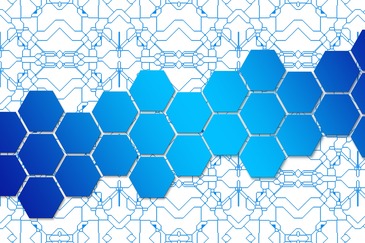
OER created at CUNY for courses in the Physical Sciences
Image by Gerd Altmann from Pixabay

Syllabus for General Astronomy at Queens College

This is a treasure hunt game that simulates various disabilities and gives a sense of how frustrating non-accessible content can be for people with disabilities. Suitable for a general audience, no programming experience necessary.
An editable copy is also given, along with ideas about how to make it more accessible.
![Air Pollution [Liberal Arts: Math and Science/Natural Science]](https://opened.cuny.edu/static/newdesign/images/materials/default-thumbnail-index.png)
This assignment was designed for students in the pathways introductory chemistry class and the first year seminar and aligns with the Inquiry and Problem Solving core competency. In this context, there is a focus on framing the issues (identifies and/or addresses questions and problems), evidence gathering (assembles, reviews and synthesizes evidence from several diverse sources), evidence (analyze the data to address the questions posed) and conclusions (critical thinking, reflect on the outcomes, draw conclusions and generate new knowledge). There is also a Global Learning component based on comparing data collected locally with corresponding data from other locations or countries. The assignment includes the written communication ability with a focus on "Content Development and Organization," as well as the clarity of the communication and its purpose. The overall aim of this assignment is to enhance students' conceptual learning and understanding of key issues related to society as well as their course. This assignment was developed as part of a LaGuardia Global Learning mini-grant and CUNY Experiential Learning and Research in the Classroom mini-grants.
The assignment will be scaffolded over about 3 weeks and is worth about 10% of the final grade.
To further increase the success of this assignment, instructors might want to consider the following: Use class discussions to focus on the relevance and importance of conceptual learning. In order to improve the data analysis aspect, incorporating class demonstrations of how to conduct the analysis and guide discussions about what the data means. Giving students more detailed rubrics with formal expectations of the requirements of the assignments, particularly in the written format Find ways to increase student participation in class discussions.
When this assignment has been utilized in previous semesters, students clearly displayed the capability to relate the co-curricular experiences in the data collection and its analysis to concepts and ideas covered during class. Evidence for this came from very dynamic and interactive class discussions based on air pollution as well as from the output of the written assignment, in which students were able to relate the nature, sources and chemical properties of the pollutants to their impact on the environment, health and society in general.
LaGuardia's Core Competencies and Communication Abilities
List the Program Goal(s) that this assignment targets
Global Learning based on comparing pollutant levels around the LaGuardia campus with those in other locations or countries. It is also an IPS assignment, incorporating scientific literacy and thinking, as students need to analyze the data, interpret it and reflect on the outcomes.
List the Student Learning Objective(s) that this assignment targets
Identify and apply fundamental chemical concepts and methods. Gather, analyze, and interpret data.
List the Course Objectives(s) that this assignment targets
Explore the complex connections between chemistry and society. Apply chemical principles to real world issues, including ethical aspects. Gather, analyze, and interpret data.
Write a short description of the pedagogy involved in executing this assignment
Students collect and analyze the data, interpret the results in terms of pollution levels, safety and ethics and compare with EPA standard levels and with levels in other countries.
Outside the classroom events will be organized for data collection. There will be class and group-based discussions focused on the data, its analysis and the connections to society.

This presentation offers an overview of the developing concept of The Anthropocene -- a term coined to describe our current geological epoch, in which human impact on the planet will leave a permanent trace.

Students, particularly those who are non-science majors, often struggle with college-level science courses required for graduation due to the applied mathematics needed to successfully complete the course. This resource includes four activities on the topics of units and measurements, dimensional analysis, density, and gases. These topics were specifically designed to teach the mathematics embedded in these topics in a culturally responsive way. Throughout the activities, we incorporate these four elements of culturally relevant pedagogy (Ladson-Billings, 2009) in order to engage students in successfully solving basic mathematics in chemistry while promoting their interest in learning chemistry.

This two week assignment asks students to interpret and analyze the 1974 Arecibo Message sent by Drake and Sagan. Week 1 introduces the concepts behind the construction of the message and engages with a critical analysis of the architecture and the contents of the message. Week 2 asks students to develop software in a Jupyter Notebook (available for free from the Anaconda Python Distribution) to interpret messages that were similar to those produced by Drake and Sagan.
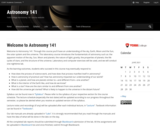
Welcome to Astronomy 141. Through this course you’ll have an understanding of the sky, Earth, Moon and the Sun, the solar system and the universe. This laboratory course introduces the fundamentals of astronomy such as: the apparent motion of the sky, Sun, Moon and planets; the nature of light; gravity; the properties of planets; the life cycles of stars; and the structure of the universe. Laboratory and computer exercises will be used, and we will conduct one nighttime lab.
As the learning outcomes, students who succeed in this course may eventually respond to:
How does the process of science work, and how does that process manifest itself in astronomy?
How is astronomy of practical use? How has astronomy impacted our understanding of our world?
What is a planet, and how are planets similar to—and different from—one another?
What is the interior of the Earth like, and how do we know?
What is a star? How are the stars similar to and different from one another?
How did the universe get started? What is likely to happen to the universe in the distant future?
[This project was created as part of the Open Pedagogy Fellowship at the Mina Rees Library, The Graduate Center].
Read more about the course design here: https://gclibrary.commons.gc.cuny.edu/2020/10/19/inclusive-education-and-research-for-astronomy/

Video lectures on atomic theory incorporating a simulated student class working problems to increase accessibility and relatablility.
Open Educational Resource funded by a City University of New York OER Grant. Produced by the Department of Chemistry, York College/CUNY and the Department of Natural Sciences, LaGuardia Community College/CUNY

Video lectures on atomic theory incorporating a simulated student class working problems to increase accessibility and relatablility.
Open Educational Resource funded by a City University of New York OER Grant. Produced by the Department of Chemistry, York College/CUNY and the Department of Natural Sciences, LaGuardia Community College/CUNY

Video lectures on atomic theory incorporating a simulated student class working problems to increase accessibility and relatablility.
Open Educational Resource funded by a City University of New York OER Grant. Produced by the Department of Chemistry, York College/CUNY and the Department of Natural Sciences, LaGuardia Community College/CUNY

Video lectures on atomic theory incorporating a simulated student class working problems to increase accessibility and relatablility.
Open Educational Resource funded by a City University of New York OER Grant. Produced by the Department of Chemistry, York College/CUNY and the Department of Natural Sciences, LaGuardia Community College/CUNY

Video lectures on atomic theory incorporating a simulated student class working problems to increase accessibility and relatablility.
Open Educational Resource funded by a City University of New York OER Grant. Produced by the Department of Chemistry, York College/CUNY and the Department of Natural Sciences, LaGuardia Community College/CUNY

Video lectures on atomic theory incorporating a simulated student class working problems to increase accessibility and relatablility.
Open Educational Resource funded by a City University of New York OER Grant. Produced by the Department of Chemistry, York College/CUNY and the Department of Natural Sciences, LaGuardia Community College/CUNY

Video lectures on atomic theory incorporating a simulated student class working problems to increase accessibility and reliability.
Open Educational Resource funded by a City University of New York OER Grant. Produced by the Department of Chemistry, York College/CUNY and the Department of Natural Sciences, LaGuardia Community College/CUNY


A new chapter in Introductory Organic Chemistry course. Lecture PowerPoint file and laboratory document are also included in this work. The goal of this chapter is to cover the basic ground of the food additives from the perspective of organic chemistry. This chapter has three parts. Part one: Introduction of the food additive industry including the history, definition and the purposes of food additives. Part two: The terminology in food additives and in organic chemistry, how to locate trustworthy data sheets for chemicals, and how to interpret the toxicity data. Part three: Different families of organic compounds used as food additives in modern food industry, discussions about their structures, chemical properties and health concerns. Lecture PowerPoint slides have all in-class questions/discussions and after-class assignments listed. Laboratory document ‰ÛÒ Synthesis of Yellow 5 (Sunset yellow), an Azo dye used in food industry. Document includes a short introduction, detailed experimental procedure and post-laboratory questions.
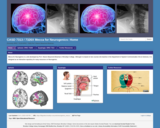
Mecca for Neurogenics is a site developed by Prof. Sharon Beaumont-Bowman of Brooklyn College. Although it is based on two courses she teaches in the Department of Speech Communication Arts & Sciences, it is designed as an interactive repository for many resources on Neurogenics.
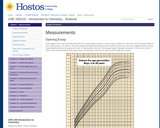
An adaptation based on chapters from the Saylor Foundation's Introductory Chemistry by David W. Ball. Chapters include: Measurements; Energy and Matter; Solids and Liquids; Atoms, Molecules, and Ions; Chemical Reactions and Equations; Stoichiometry and the Mole; Nuclear Chemistry; Chemical Bonds; Gases; Solutions; Acids and Bases; Chemical Equilibrium; and Organic Chemistry. Includes Labs.

Adaptation of Saylor Foundation's The Basics of General, Organic, and Biological Chemistry by David W. Ball, John W. Hill, and Rhonda J. Scott. Chapters include: Organic Chemistry Review / Hydrocarbons; Alcohols, Phenols, Thiols, Ethers; Aldehydes, Keytones; Carboxylic Acids, Esters; Amines and Amides; Carbohydrates; Lipids; Amino Acids; Proteins and Enzymes; Nucleic Acids and Protein Synthesis; and Metabolic Pathways and Energy Production.
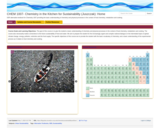
Course Goals and Learning Objectives. The goal of this course is to give the student a basic understanding of chemistry and physical processes in the context of food chemistry, metabolism and cooking. The course also necessarily makes connections to the future sustainability of food and water. We aim to prepare the student for the increasingly urgent and complex national dialogue on the interrelated topics of global climate change, energy, pollution, extinction and the food supply. The specific objectives of this course are to provide the student with the basic vocabulary of chemistry, and a basic understanding of the experimental process as it relates to food chemistry and cooking.